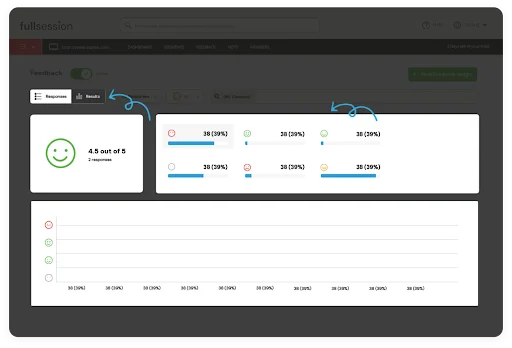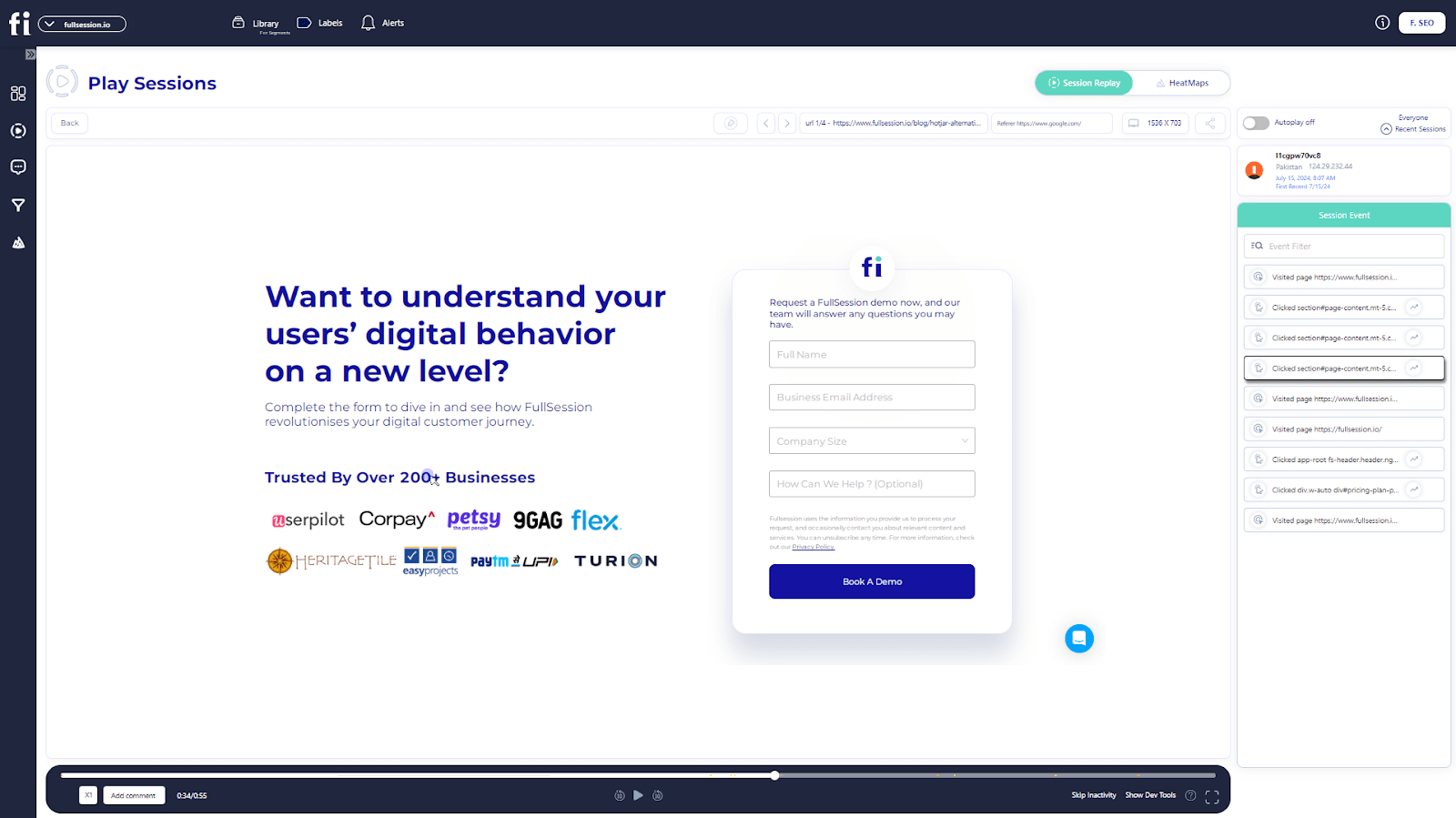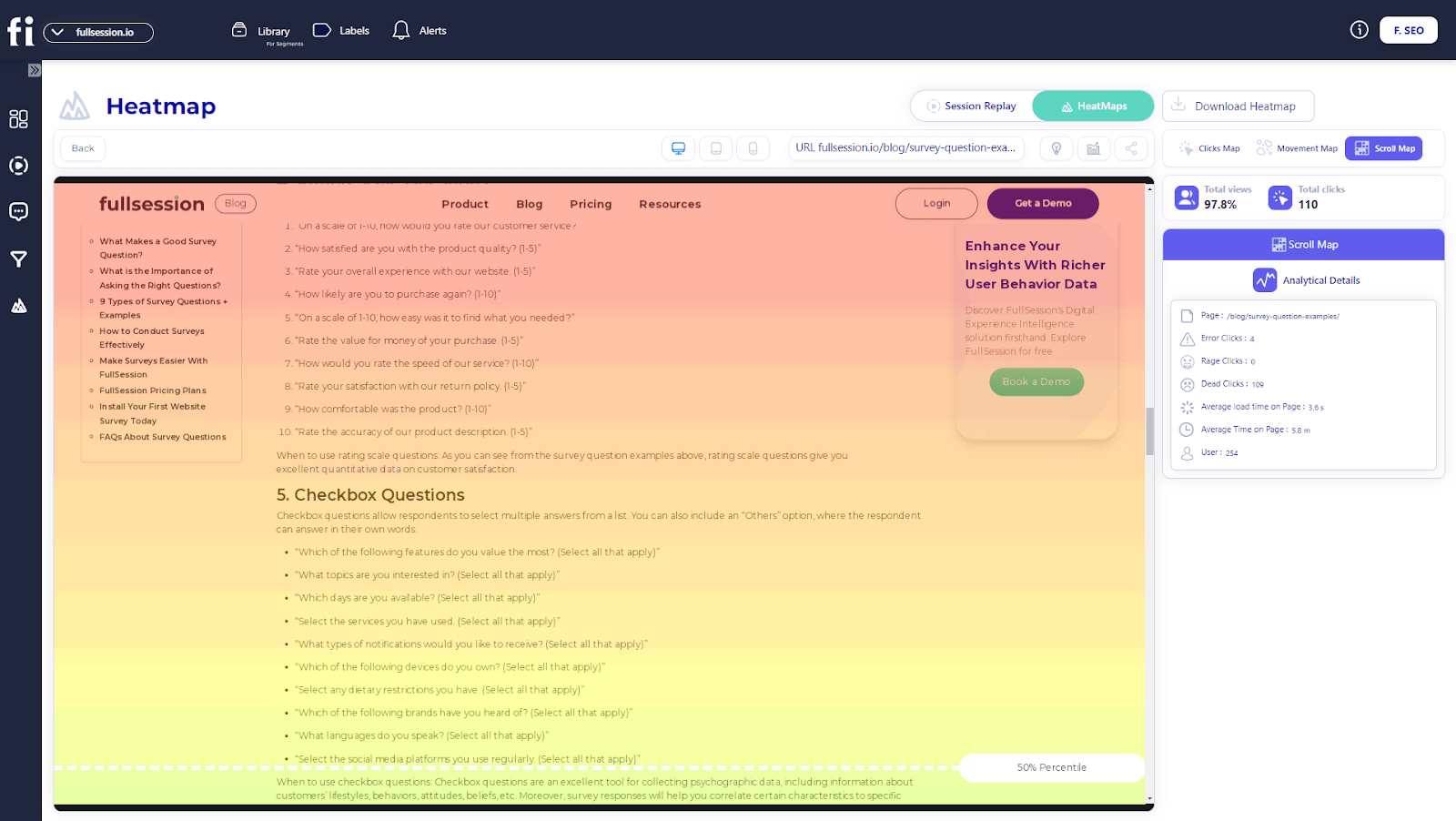As an online business owner, you must know how your users interact with your web app, landing page, website, or...
Bad user experience on a website is why 88% of online shoppers don’t want to repeat their visit. If you want your customers to return, invest in UX tools, as statistics show us that for every $1 spent, there is a $100 return.
If you want your online business to grow, there’s no doubt that user experience analysis is worth your time and money. In this article, we will discuss best practices to approach UX analysis and the benefits of using UX analytics tools.
We will also show you how easy it is to conduct a comprehensive customer experience analysis using FullSession. Our web analytics software does all the hard work for you. It helps you determine which features need improvement by tracking and comparing user actions across different devices, channels, and periods.
Getting started with the FullSession 14-day free trial is easy and will take a few minutes of your time. All you need to do is type your email and password to start testing how FullSession can help you improve the user experience on your website.
Now, let’s talk about user experience analysis and why you should focus on it.
What is user experience analysis?
UX analysis includes investigating and assessing how users interact with the UI of a website, web app, or landing page and using the collected data to improve the user experience. The aim is to enhance the user flow and the product’s ease of use.
What’s the core of successful UX analysis? Understanding the user: empathy with their expectations, wants, and perceptions of the product. This knowledge is precious since user experience and web design significantly affect conversion rates.
Why is user experience analysis important?
Effective UX analysis brings many benefits to your business. Here are some examples.
UX analysis helps you find any existing issues on your website
Since the aim is to create a frictionless and enjoyable experience, it is essential to identify what difficulties the user encounters during a website visit.
User experience analysis improves SEO
It shows you what terms users type into the search bar, what problems they need to solve in the first place, and to what pages they devote most of their time. Conducting the analysis gives you a clear picture of what keywords you should focus on when designing content for your web pages.
UX analysis helps you outrank your competitors
There’s no need to copy what they are doing because it may not work in your case. Thanks to UX analysis, you can design your path to success and adequately react to the challenges that occur in the market.
Why should you design a user-centric product?
Frank Chimero said: “People ignore design that ignores people.” So it’s crucial to know the user perspective and do everything to improve the overall performance of your product. You’ll learn what you need to focus on to create a user-centered design by involving UX analysis tools. By doing this, you will:
1. Become innovative
Involving customers in the design process leads to insights that allow the creation of innovative products or services.
2. Create a positive user experience
There is no better advertisement for your business than a satisfied customer who is eager to spread the word about the positive experience with your company. It also leads to increased customer loyalty.
3. Avoid wasting time and money
It is essential to test your product with end-users when it is still possible to make changes at a low cost.
4. Boost your sales
Creating a user-centric product that goes right into customers’ needs increases the chance of making repeated purchases.
5. Become more competitive
When you offer products that match your customers’ needs, they are less likely to choose competitors’ products.
Who should be involved in your UX process?
To create better products, you need to develop them with user experiences in mind, and you need appropriate people who will help you achieve your product goals. With the growth of awareness about the importance of user experience, we can observe an increasing demand for UX professionals.
So how should you organize your UX team? You need to combine different perspectives and expertise from various individuals. Key UX roles include professionals like:
1. UX researchers
What are the reasons behind users’ behaviors, and what motivates them? What do they need? The role of a UX researcher is to find answers to these questions by engaging with target users. They conduct carefully planned UX research sessions.
UX researchers must discuss research requirements with other team members and stakeholders, choose the most appropriate research method, determine research questions, and enlist participants.
Creating a budget for the research project and deciding what timeframe it’s going to take place is also a task of a UX researcher. Finally, there comes the time for their core activity: carrying out the research, conducting data analysis, and reporting results.
2. UX designers
UX designers always work with the end-user in mind. Their core task is to ensure products and services they are working on will be accessible and enjoyable for the user. Therefore UX designers have their role in each part of the UX design process: planning, conducting research, creating prototypes, and testing products with users.
A UX designer has to detect how the user’s interaction with a product flows and make the experience as smooth as possible. Their role is to understand the user’s needs and develop creative solutions to their problems.
They design the best user flows and devise user journey maps to achieve that. When the design is ready, they try to find if there’s a need to improve it by conducting user testing.
3. UI designers
UI designers create all the visual parts of a product. Their role is to design screens with interactive elements like menu bars, icons, buttons, and color palettes. While designing a product, they have to consider how different screen sizes will display the design. To make the design coherent, they create style guides and maintain them.
Their goal is to produce a visually engaging user interface. It must be easy to follow and intuitive. When creating the UI, they take the user’s point of view as the starting point.
Apart from that, UX designers conduct a competitive analysis of product use and feel and ensure all design elements maintain cohesive branding.
4. UX writers
Users can’t navigate a product without text. They encounter welcome screens, various notifications, calls to action, and error messages on their journey. The UX writer’s role is to create user-friendly copy to guide users and help them achieve their goals.
UX writers make product navigation easy by creating a copy for each user touchpoint. Beyond that, they also take care of the UX content strategy.
Their qualifications need to combine good writing skills and strong knowledge of the whole design process. They need to show a complete understanding of UX best practices to arrange an excellent user experience while closely collaborating with the UX design team.
5. UX managers
A UX design team needs a wholesome strategy to work correctly. The UX manager role is similar to any other manager’s. Apart from managing performance and budgeting, they need to show a deep understanding of UX discipline.
UX managers have to hire the best professionals to create a strong interdisciplinary team with diverse skills and expertise. The manager has to direct the team creatively and help them generate, develop and refine their ideas. Above all, the manager needs to ensure the team is up to date with the newest trends and always ready to gain new experiences and knowledge.
In any case, UX managers need to oversee the work of the UX team toward common goals while having shared values. They have to find a balance between the user needs and the business strategy. How do they achieve that? For instance, they run usability testing and present the results to the key stakeholders.
6. UX strategists
UX strategist takes consumer insights gathered from research, UX best practices, and psychology and, with the consumer-centric approach in mind, helps the company make strategic decisions. The UX strategist injects the customer perspective into the organization’s strategy.
The strategist has to ensure there is an actual demand for the product that the company will release. The strategist’s responsibilities include stakeholder interviews, competitive analysis, and, above all, user research.
Then, the strategist synthesizes all the discoveries into one strategic process and delivers it in presentation decks and strategy briefs to partners, clients, and colleagues. What’s more, the strategist has to cooperate with designers and developers to watch the design and implementation processes of the product to make sure it meets business goals and the original vision.
Companies know that by placing the user at the center of their design choices, they are on a good way to outsmart the competition.
Now it’s time to discuss how customer experience analysis looks in detail.
The two main types of user experience analysis
How to pinpoint the needs of your audience? How to develop a product that will meet these needs precisely? The answer is simple: research is the key.
UX analysis helps to identify issues and find opportunities to solve the problems. It falls into two important subcategories: quantitative and qualitative user experience analysis.
Quantitative user experience analysis
Quantitative user experience analysis is all about numbers. It gives product teams numerical or statistical data to show how effective their products are. It provides a picture of the final product’s usability, but you can also apply it to comparing competitive products. It helps you find responses to queries like how many and how often.
The results of quantitative UX research can be easily presented in charts or graphs. They are relatively free from human bias since they are obtained in a structured testing environment under strict control.
Apart from these advantages, quantitative UX research also has some downsides. It doesn’t explain the reasons behind specific trends or patterns. It only gives you an overview of what is happening. It also can add up a lot of costs since, to obtain statistical significance, you need a large sample size.
Qualitative user experience analysis
Qualitative user experience analysis focuses on subjective information. It gives you a picture of how users experience your product and gathers insights from real users to help you find ways of improvement. Qualitative user research explains data obtained by quantitative analysis.
The qualitative data can show how effective the final product is and can influence your choices when the product is still under creation. You can conduct qualitative user research at different stages of the design process. Qualitative research is also valuable when you need to redesign your website, web app, or landing page.
Qualitative UX research is easy to organize: 5-8 participants are enough to conduct a study. It gives the researchers insight into the emotions and minds of the users, as they are often encouraged to think aloud when interacting with a product.
Now that we know the main types of UX analysis, let’s see the advantages of conducting it.
The benefits of the user experience analysis
UX analysis lets you solve your UX issues quickly and affordably. It helps you avoid negative reviews and increase user retention. But that’s not all. Here’s a list of some of the most important benefits of UX analysis:
1. Cost reduction
It’s incomparably cheaper to find usability issues at an early stage of product development than to fix them when the process further progresses.
2. Increased conversion rate
Good UX finds ways to make site navigation as easy as possible. When visitors can easily find what they are looking for without bumping into unnecessary steps, vague calls to action, or over-complex design, the website’s conversion rate can increase by 400%.
3. Increased customer loyalty
If your website provides an enjoyable experience, there are higher chances that the customer will return. Delivering a good user experience is also the best way to convert visitors into buyers. Happy customers are likely to share a word of mouth about the positive experience with your website, product, or app on social media or with ratings and reviews.
4. SEO boost
Search engines promote websites that provide a good user experience. If you conduct UX analyses regularly, you increase users’ chances to discover your website, web app, or landing page.
Now that we know how valuable user experience analysis is, let’s look at how FullSession software can help you conduct it.
How to perform user experience analysis with FullSession
FullSession lets you find out how your website visitors behave and discover the reasons behind their actions. Equipped with this knowledge, you will know exactly which website elements to improve and how to solve problems effectively. FullSession provides you with tools to gather both quantitative data and qualitative data.
Quantitative UX analysis
FullSession offers two tools to analyze quantitative data: customer feedback widget and interactive heatmaps. Here’s how they work.
1. Customer feedback widget

How do users experience your website? You can gather information directly from them by creating user feedback forms. Most users like being helpful, especially when they can see tangible results of their contributions.

You can design your customer feedback form to fit mobile or desktop screens. The widget lets you choose the page position of the form, reactions style, language, and colors to align the form with your branding.
2. Interactive heatmaps

Aggregated data doesn’t give you an accurate picture of user behavior on your website. Relaying on it when creating the product can be tricky. It is where FullSession interactive heatmaps come in handy. They give you a real-time picture of visitors’ mouse movements, clicks, and scrolls across your website.
Heatmaps allow you to monitor the user journey. You will know where exactly in the sales funnel the user got stuck and where he dropped off. This information will empower you to appropriately change the design and welcome each visitor with a more personalized experience.
Qualitative UX analysis
In the UX analysis process, there comes a time to answer why certain events occur. The best way to find a response is by qualitative research. FullSession gives you session recording and replay tools to watch visitors on your website in action. Here’s a close-up of how they work.
1. Session recordings
The session recordings let you discover what problems users encounter on your website. It will give you a clear picture of what you can improve to avoid repeating the same issues in the future. When you log into the FullSession dashboard, you will see what users do in real-time: their clicks, mouse movements, and taps.
Head to the Session Playlist of your dashboard to see the list of available session recordings. Click the play button to see the session that interests you.

Watching session recordings and tracking website visitors helps you understand what changes are necessary to improve the user flow.
2. Session replays
Session replays give you access to several features. With them, you will easily document any valuable data. For example, you will be able to tag recordings, add a comment for your team members, or copy and share session recording links.
Session recordings are available for watching in full-screen mode, and you can fast forward, rewind or pause each session replay up to eight times.

The session replay feature provides you with the following data:
- User location by country and IP address
- Visit source
- Pages viewed by users
- Average and total times of page visit
- Session list
- Screen resolutions of your user’s devices
- The session event data.
After conducting the analysis, the next step is to organize the data correctly.
Use insights for website redesign and increased customer engagement
Without good organization, you will get lost trying to review thousands of data points. But where to start? Here’s a six-step plan to systematize your insights and make good use of them.
1. Learn what problems users encounter when using your product
Use qualitative data to pinpoint the most common issues. For example, if many users indicate that they don’t know how to access a feature your product offers, you will know you should focus on this issue as one of your priorities.
2. Sort out your UX data by adding categories and tags
When organizing your data, you may discover that attempts to complete specific tasks cause similar issues for different users. Group them according to categories and add tags that will help you filter your data quickly.
3. Identify repeating patterns and pain points users encounter
Session recording analysis will show you the reasons why the issues occur. Then you should group the issues around specific actions, find out how many users experience similar problems, and identify how often they happen.
4. Categorize fixes in terms of importance
Once you discover what type of friction users experience with your product, look at your list of issues and decide what problems need to be addressed in the first place. Instead of directing your attention to minor issues that only annoy the visitors but don’t cause them to bounce off, focus on critical problems that prevent users from converting.
5. Prepare a report
After gathering your data, conducting an evaluation, and deciding on your top priorities, you can present the results to your product team. You should emphasize the critical issues and give them all details. Support it by evidence in the form of screenshots or session replays. Don’t forget to add information about what’s working well to motivate your team.
Use FullSession to design a perfect website
These days online businesses need to show a customer-centric approach to be successful. How the users interact with your website and what their experience is should influence the choices you make when designing, implementing, and improving your website.
FullSession provides you with comprehensive web analytics tools that help you analyze visitor behavior in detail and discover any friction points that cause funnel dropouts and decrease conversion rates. Our advanced filtering options give you a better picture of visitors’ digital experience and help you pinpoint sessions where user flow is interrupted.
With FullSession, you will track critical metrics and access data visualization in real-time. What’s more, FullSession gathers data analysis and lets you track visitor behavior without affecting the performance of your website.
With FullSession, you can get a clear picture of how you can improve user experience on your website and increase conversion rates. Our Basic Plan starts at $39 a month, but you can start a free trial right away. Sign up today and test all available features.
Please read further to learn more about how UX Design for Enterprise Apps can have an impact on users´ mental health and productivity.





